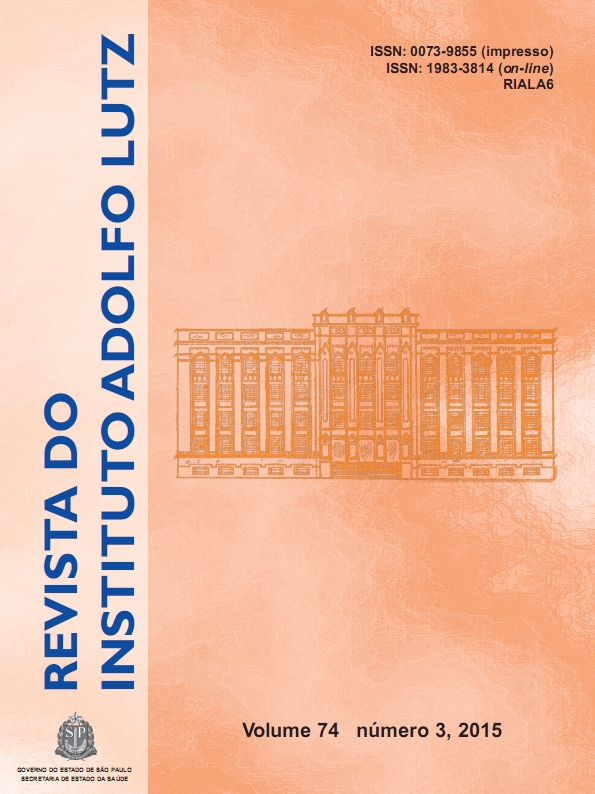Abstract
Airborne fungi are important food contaminants and spoiling agents, especially in fruits and their derivatives. This study aimed at identifying the main fungi in the airborne microbiota in a fruit pulp industry, located in Paraíba State, and to investigate the antifungal action of terpenes as an alternative for controlling fungal growth. The Petri plates containing Sabouraud dextrose agar with chloramphenicol (50 μg/mL) were exposed for collecting the fungi. The plates were incubated at 28 °C for seven days; then the colony forming unitscounting, and description were performed. The identification of fungi was performed by the morphological analysis of isolated colonies. The main group of fungi isolated throughout the industry was Cladosporium spp. Antifungal tests were performed by diffusion technique in solid medium with discs containing terpenes: carvacrol, citronellal, citral, linalool, thymol, terpinolene, p-cymene and β-caryophyllene. The effectiveness of some of these terpenes against Cladosporium spp. strains was shown, especially citral and carvacrol. Based on these results, the fruit pulp industry shows vulnerable ambient air, notably with high contamination by Cladosporium spp. Thus, it is aimed at promoting further studies with natural drugs in order to reduce the fungal contamination in food.
References
1. Riedel G. Controle sanitário dos alimentos. 3ª ed. São Paulo: Atheneu; 2005.
2. Mageste JO, Pereira TCD, Silva GA, Barros RAM. Estudo da microbiota fúngica anemófila de uma indústria farmacêutica de juiz de fora – MG. Rev Facider.2012;1(1):1-7.
3. Silva LF. Fungos: um estudo sobre sua ocorrência nos alimentos [trabalho de conclusão de curso]. Belo Horizonte (MG): Universidade Federal de Minas Gerais; 2008.
4. Souza PMS, Andrade SL, Lima AF. Pesquisa, isolamento e identificação de fungos anemófilos em restaurantes self-service do centro de Maceió /AL. Cad Grad Cienc Biol Saúde.2013;1(3):147-54.
5. Zandonadiet RP, Botelho RBA, Sávio KEO, Akutsu RC, Araújo WMC. Atitudes de risco do consumidor em restaurantes de auto-serviço. Rev Nutr.2007;20(1):19-26. [DOI: dx.doi.org/10.1590/S1415-52732007000100002].
6. Dal RI, Sebastiany E. Avaliação do Processo Produtivo e da Qualidade de Polpas de Frutas Comercializadas em Boa Vista/RR [dissertação de mestrado]. Boa Vista (RR): Universidade Federal de Roraima;2006.
7. Corrêa B. Micotoxinas humanas e micetismos. In: Zaitz, C Campbell, Marques AS, Ruiz LRB, Souza VM. Compêndio de micologia médica. Rio de Janeiro: Medsi; 1998.
8. Bakkali F, Averbeck S, Averbeck D, Idaomar M. Biological effects of essential oils - a review. Food Chem Toxicol.2008;46(2):446-75. [DOI: 10.1016/j.fct.2007.09.106].
9. Kern ME, Blevins KS. Micologia Médica:texto e atlas. 2ed. São Paulo: Premier; 1999.
10. Lacaz CS, Porto E, Martins JEC, Heins-Vaccari EM, Melo NT. Tratado de micologia médica. 9 ed. São Paulo: Sarvier; 2002.
11. Rasooli I, Abyaneh MR. Inhibitory effect of thyme oils on growth and aflatoxin production by Aspergillus parasiticus. Food Control.2004;15(6):479-83. [DOI: 10.1016/j.foodcont.2003.07.002].
12. Mota KSL, Pereira FO, Oliveira WA, Lima IO, Lima EO. Antifungal activity of Thymus vulgaris L. essential oil and its constituent phytochemicals against Rhizopus oryzae: interaction with ergosterol. Molecules.2012;17(12):14418-33. [DOI: 10.3390/molecules171214418].
13. Hadecek F, Greger H. Testing of antifugal natural products: methodilogies, comparability of results and assay choice. Phytochem Anal. 2000;11(3):137-47. [DOI: 10.1002/(SICI)1099-1565(200005/06)11:3<137::AID-PCA514>3.0.CO;2-I].
14. Stelato MM, Concon MM, Shimada D, Srebernich SM. Contaminação fúngica em barras de cereais comercializadas. Rev Inst Adolfo Lutz.2010;69(3):285-90.
15. Altunatmaz SS, Issa G, AydinA. Detection of airborne psychrotrophic bacteria and fungi in food storage refrigerators. Braz J Microbiol.2012;43(4):1436-43. [DOI: dx.doi.org/10.1590/S1517-83822012000400027].
16. Sorensen LM, Jacobsen T, Nielsen PV, Frisvad JC, Koch AG. Mycobiota in the processing areas of two different meat products.Int J Food Microbiol. 2008;124(1):58-64. [DOI: 10.1016/j.ijfoodmicro.2008.02.019].
17. Gava AJ, Silva CAB, Frias JRG. Tecnologia de alimentos: Princípios e Aplicações. São Paulo: Nobel; 2009.
18. Vecchia AD, Fortes CR. Contaminação fúngica em granola comercial. Cienc Tecnol Aliment. 2007;27(2):324-7. [DOI: dx.doi.org/10.1590/S0101-20612007000200020].
19. Engelhart S, Glasmacher A, Simon A, Exner M. Air sampling of Aspergillus fumigates and other thermotolerant fungi: comparative performance of the Sartorius MD8 airport and the Merck MAS-100 portable bioaerosol sampler. Inter J Hyg Environ Health. 2007;210(6):733-9. [DOI: 10.1016/j.ijheh.2006.10.001].
20. Zoppas BCA, Valencia-Barrera RM, Fernández-Gonzáles D. Distribuição de esporos de Cladosporiumspp. no ar atmosférico de Caxias do Sul, RS, Brasil, durante dois anos de estudo. Rev Bras Alerg Imunopatol.2011;34(2):55-8.
21. Rivas S, Thomas CM. Molecular interactions between tomato and the leaf mold pathogen Cladosporium fulvum. Ann Rev Phytopathol. 2005;43:395-436. [DOI: 10.1146/annurev.phyto.43.040204.140224].
22. Portnoy JM, Barnes CS, Kennedy K. Sampling for indoor fungi. J Allergy Clin Immunol.2004; 113(2):189-98. [DOI: 10.1016/j.jaci.2003.11.021].
23. Souza GC, Carneiro JGG J, Gonsalves HRO. Qualidade microbiológica de polpas de frutas congeladas produzidas no município de Russas – CE. ACSA. 2011;7(3):1-5.
24. Lima EO, Gompertz OF, Giesbrecht AM, Paulo MQ. In vitro antifungal activity of essential oils obtained from officinal plants against dermatophytes. Mycoses. 1993;36(9-10):333-6. [DOI: 10.1111/j.1439-0507.1993.tb00777.x].
25. Lima IO, de Medeiros Nóbrega F, de Oliveira WA, de Oliveira Lima E, Albuquerque Menezes E, Cunha FA, et al. Anti-Candida albicans effectiveness of citral and investigation of mode of action. Pharm Biol.2012;50(12):1536-41. [DOI: 10.3109/13880209.2012.694893].
26. Garcia R, Alves ESS, Santos MP, Viegas Aquije GMF, Fernandes AAR, dos Santos RB, et al. Antimicrobial activity and potential use of monoterpenes as tropical fruits preservatives. Braz J Microbiol.2008;39(1):163-8. [DOI: 10.1590/S1517-838220080001000032].
27. Saddiq AA, Khayyat SA. Chemical and antimicrobial studies of monoterpene: Citral. Pesticide Biochem Physiol. 2010;98(1):89-93.[DOI: 10.1016/j.pestbp.2010.05.004].
28. Lima IO, Pereira FO, Oliveira WA, Lima EO, Menezes EA, Cunha FA, et al. Antifungal activity and mode of action of carvacrol against Candida albicans strains. J Essent Oil Res.2013;25(2):138-42.
29. Abbaszadeh S, Sharifzadeh A, Shokri H, Khosravi AR, Abbaszadeh A. Antifungal efficacy of thymol, carvacrol, eugenol and menthol as alternative agents to control the growth of food-relevant fungi. J Mycol Med. 2014;24(2):51-6. [DOI: 10.1016/j.mycmed.2014.01.063].

This work is licensed under a Creative Commons Attribution 4.0 International License.
Copyright (c) 2016 Instituto Adolfo Lutz Journal
